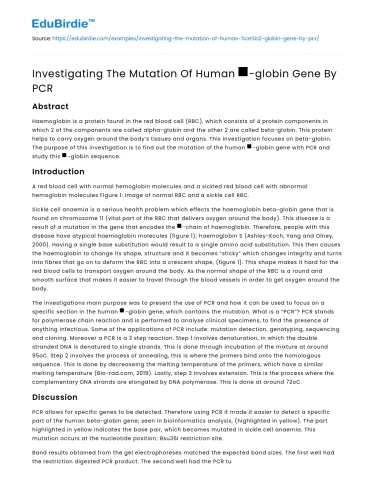Abstract
Haemoglobin is a protein found in the red blood cell (RBC), which consists of 4 protein components in which 2 of the components are called alpha-globin and the other 2 are called beta-globin. This protein helps to carry oxygen around the body’s tissues and organs. This investigation focuses on beta-globin. The purpose of this investigation is to find out the mutation of the human β-globin gene with PCR and study this β-globin sequence.
Introduction
A red blood cell with normal hemoglobin molecules and a sickled red blood cell with abnormal hemoglobin molecules Figure 1: image of normal RBC and a sickle cell RBC.
Save your time!
We can take care of your essay
- Proper editing and formatting
- Free revision, title page, and bibliography
- Flexible prices and money-back guarantee
Sickle cell anaemia is a serious health problem which effects the haemoglobin beta-globin gene that is found on chromosome 11 (vital part of the RBC that delivers oxygen around the body). This disease is a result of a mutation in the gene that encodes the β-chain of haemoglobin. Therefore, people with this disease have atypical haemoglobin molecules (figure 1); haemoglobin S (Ashley-Koch, Yang and Olney, 2000). Having a single base substitution would result to a single amino acid substitution. This then causes the haemoglobin to change its shape, structure and it becomes “sticky” which changes integrity and turns into fibres that go on to deform the RBC into a crescent shape, (figure 1). This shape makes it hard for the red blood cells to transport oxygen around the body. As the normal shape of the RBC is a round and smooth surface that makes it easier to travel through the blood vessels in order to get oxygen around the body.
The investigations main purpose was to present the use of PCR and how it can be used to focus on a specific section in the human β-globin gene, which contains the mutation. What is a “PCR”? PCR stands for polymerase chain reaction and is performed to analyse clinical specimens, to find the presence of anything infectious. Some of the applications of PCR include: mutation detection, genotyping, sequencing and cloning. Moreover a PCR is a 3 step reaction. Step 1 involves denaturation, in which the double stranded DNA is denatured to single strands. This is done through incubation of the mixture at around 95oC. Step 2 involves the process of annealing, this is where the primers bind onto the homologous sequence. This is done by decreaseing the melting temperature of the primers, which have a similar melting temperature (Bio-rad.com, 2019). Lastly, step 3 involves extension. This is the process where the complementary DNA strands are elongated by DNA polymerase. This is done at around 72oC.
Discussion
PCR allows for specific genes to be detected. Therefore using PCR it made it easier to detect a specific part of the human beta-globin gene; seen in bioinformatics analysis, (highlighted in yellow). The part highlighted in yellow indicates the base pair, which becomes mutated in sickle cell anaemia. This mutation occurs at the nucleotide position; Bsu36I restriction site.
Band results obtained from the gel electrophoreses matched the expected band sizes. The first well had the restriction digested PCR product. The second well had the PCR tube and the third well had the control tube. The bands and base pairs are shown above.
In the future, to obtain more accurate and reliable results, it is key to make sure all risks on contaminations have been minimised as much as possible. More specifically the TM for the primers and the PCR machine must be correct otherwise it would affect the results. Initial denaturation and denaturation require a temperature of 94oC. Annealing requires a temperature of 55oC, and extension and the final extension require a temperature of 72oC. Moreover, it is important that when mixing and transferring the reaction components to be careful as the smallest carelessness would affect the whole sample as it would give the wrong bands in the analysis using gel electrophoreses.
Overall this investigation was a success. The specific gene was identified and analysed using a PCR.
References
- Wang X, Seed B. A PCR primer bank for quantitative gene expression analysis. Nucleic Acids Res. 2003;31(24):e154. doi:10.1093/nar/gng154
- Ashley-Koch, A., Yang, Q. and Olney, R. (2000). Sickle Hemoglobin (Hb S) Allele and Sickle Cell Disease: A HuGE Review. American Journal of Epidemiology, 151(9), pp.839-845.
- Bio-rad.com. (2019). PCR (Polymerase Chain Reaction) | LSR | Bio-Rad. [online] Available at: https://www.bio-rad.com/en-us/applications-technologies/pcr-polymerase-chain-reaction?ID=LUSNYI15 [Accessed 18 Dec. 2019].
- Moosa, Mahdi. (2008). Analysis of beta-globin gene mutations in a beta-thalassaemic patient and predicting their relative role in disease prognosis. 10.13140/2.1.4692.5768.
- Kent WJ, Sugnet CW, Furey TS, Roskin KM, Pringle TH, Zahler AM, Haussler D. The human genome browser at UCSC. Genome Res. 2002 Jun;12(6):996-1006.
- Grehl, C., Kuhlmann, M., Becker, C., Glaser, B. and Grosse, I. (2019). How to Design a Whole-Genome Bisulfite Sequencing Experiment.






 Stuck on your essay?
Stuck on your essay?

